Changes in Sea Surface Temperature and Sea Ice Concentration in the Arctic Ocean over the Past Two Decades
Abstract
1. Introduction
2. Data
2.1. Sea Surface Temperature
2.2. Sea Ice Concentration
2.3. Sea Ice Extent
3. Methods
3.1. Resampling Method
3.2. Linear Regression Analysis
3.3. Correlation Analysis
4. Definition of Sea Ice Melting and Freezing Processes
4.1. Sea Ice Break-Up and Melt Completely
4.2. Sea Ice Freeze-Up and Freeze Completely
5. Result and Analysis
5.1. Spatiotemporal Variation of SST and Sea Ice
5.2. Response of SST to Sea Ice Concentration
5.2.1. Correlation between SST and SIC
5.2.2. Melting and Freezing Processes of Sea Ice
5.2.3. Early Melting and Late Freezing
6. Discussion
7. Conclusions
Author Contributions
Funding
Data Availability Statement
Acknowledgments
Conflicts of Interest
References
- Graversen, R.G.; Mauritsen, T.; Tjernström, M.; Källén, E.; Svensson, G. Vertical structure of recent Arctic warming. Nature 2008, 451, 53–56. [Google Scholar] [CrossRef] [PubMed]
- Cao, Y.; Liang, S. Recent advances in driving mechanisms of the Arctic amplification: A review. Chin. Sci. Bull. 2018, 63, 2757–2774. [Google Scholar] [CrossRef]
- Chylek, P.; Folland, C.; Klett, J.D.; Wang, M.; Hengartner, N.; Lesins, G.; Dubey, M.K. Annual Mean Arctic Amplification 1970–2020: Observed and Simulated by CMIP6 Climate Models. Geophys. Res. Lett. 2022, 49, e2022GL099371. [Google Scholar] [CrossRef]
- Parracho, A.C.; Safieddine, S.; Lezeaux, O.; Clarisse, L.; Whitburn, S.; George, M.; Prunet, P.; Clerbaux, C. IASI-Derived Sea Surface Temperature Data Set for Climate Studies. Earth Space Sci. 2021, 8, e2020EA001427. [Google Scholar] [CrossRef]
- Donlon, C.J.; Martin, M.; Stark, J.; Roberts-Jones, J.; Fiedler, E.; Wimmer, W. The Operational Sea Surface Temperature and Sea Ice Analysis (OSTIA) system. Remote Sens. Environ. 2012, 116, 140–158. [Google Scholar] [CrossRef]
- Bell, M.J.; Forbes, R.M.; Hines, A. Assessment of the FOAM global data assimilation system for real-time operational ocean forecasting. J. Mar. Syst. 2000, 25, 1–22. [Google Scholar] [CrossRef]
- Martin, M.J.; Hines, A.; Bell, M.J. Data assimilation in the FOAM operational short-range ocean forecasting system: A description of the scheme and its impact. Q. J. R. Meteorol. Soc. 2007, 133, 981–995. [Google Scholar] [CrossRef]
- Marullo, S.; Minnett, P.J.; Santoleri, R.; Tonani, M. The diurnal cycle of sea-surface temperature and estimation of the heat budget of the Mediterranean Sea. J. Geophys. Res. Ocean. 2016, 121, 8351–8367. [Google Scholar] [CrossRef]
- Copernicus Ocean State Report, issue 6. J. Oper. Oceanogr. 2022, 15, 1–220. [CrossRef]
- Zheng, C.; Zhou, L.; Song, S.; Pan, J. Long term trend of global sea surface temperature from 1870 to 2011. J. Oceanol. Limnol. 2013, 5, 1123–1129. [Google Scholar]
- Carvalho, K.S.; Wang, S. Sea surface temperature variability in the Arctic Ocean and its marginal seas in a changing climate: Patterns and mechanisms. Glob. Planet. Chang. 2020, 193, 103265. [Google Scholar] [CrossRef]
- Qi, Q.; Cai, R. The relationship between the oscillation of western Pacific warm pool and sea surface temperature anomalies in equatorial central and eastern Pacific. Mar. Sci. 2015, 9, 77–85. [Google Scholar] [CrossRef]
- Qiu, Y.; Massimo, M.; Li, X.; Birendra, B.; Joni, K.; Narantuya, D.; Liu, S.; Gao, Y.; Cheng, B.; Wu, T.; et al. Observing and understanding high mountain and cold regions using big earth data. Bull. Chin. Acad. Sci. 2017, 32, 82–94. [Google Scholar]
- Docquier, D.; Koenigk, T. A review of interactions between ocean heat transport and Arctic sea ice. Environ. Res. Lett. 2021, 16, 123002. [Google Scholar] [CrossRef]
- Leppäranta, M. Drift ice material. In The Drift of Sea Ice, 2nd ed.; Springer: Heidelberg, Germany, 2011; pp. 11–63. [Google Scholar] [CrossRef]
- Kodaira, T.; Waseda, T.; Nose, T.; Inoue, J. Record high Pacific Arctic seawater temperatures and delayed sea ice advance in response to episodic atmospheric blocking. Sci. Rep. 2020, 10, 20830. [Google Scholar] [CrossRef] [PubMed]
- Shen, X.; Zhang, Y.; Chen, C.; Hu, S. Long-term spatial and temporal variations of sea ice in the northwest passage of the Canadian Arctic Archipelago. Chin. J. Polar Res. 2021, 33, 71–87. [Google Scholar] [CrossRef]
- Buixadé Farré, A.; Stephenson, S.R.; Chen, L.; Czub, M.; Dai, Y.; Demchev, D.; Efimov, Y.; Graczyk, P.; Grythe, H.; Keil, K.; et al. Commercial Arctic shipping through the Northeast Passage: Routes, resources, governance, technology, and infrastructure. Polar Geogr. 2014, 37, 298–324. [Google Scholar] [CrossRef]
- Stephenson, S.R.; Wang, W.; Zender, C.S.; Wang, H.; Davis, S.J.; Rasch, P.J. Climatic Responses to Future Trans-Arctic Shipping. Geophys. Res. Lett. 2018, 45, 9898–9908. [Google Scholar] [CrossRef]
- Wagner, P.M.; Hughes, N.; Bourbonnais, P.; Stroeve, J.; Rabenstein, L.; Bhatt, U.; Little, J.; Wiggins, H.; Fleming, A. Sea-ice information and forecast needs for industry maritime stakeholders. Polar Geogr. 2020, 43, 160–187. [Google Scholar] [CrossRef]
- Melia, N.; Haines, K.; Hawkins, E.; Day, J.J. Towards seasonal Arctic shipping route predictions. Environ. Res. Lett. 2017, 12, 084005. [Google Scholar] [CrossRef]
- Simmonds, I.; Keay, K. Extraordinary September Arctic sea ice reductions and their relationships with storm behavior over 1979–2008. Geophys. Res. Lett. 2009, 36, L19715. [Google Scholar] [CrossRef]
- Keay, K.; Burke, C.; Simmonds, I. Arctic Climate Change as Manifest in Cyclone Behavior. J. Clim. 2008, 21, 5777–5796. [Google Scholar] [CrossRef]
- Rudeva, I.; Simmonds, I. Variability and Trends of Global Atmospheric Frontal Activity and Links with Large-Scale Modes of Variability. J. Clim. 2015, 28, 3311–3330. [Google Scholar] [CrossRef]
- Kumar, A.; Yadav, J.; Mohan, R. Spatio-temporal change and variability of Barents-Kara sea ice, in the Arctic: Ocean and atmospheric implications. Sci. Total Environ. 2021, 753, 142046. [Google Scholar] [CrossRef]
- Chen, J.; Kang, S.; You, Q.; Zhang, Y.; Du, W. Projected changes in sea ice and the navigability of the Arctic Passages under global warming of 2 °C and 3 °C. Anthropocene 2022, 40, 100349. [Google Scholar] [CrossRef]
- Landy, J.C.; Dawson, G.J.; Tsamados, M.; Bushuk, M.; Stroeve, J.C.; Howell, S.E.L.; Krumpen, T.; Babb, D.G.; Komarov, A.S.; Heorton, H.D.B.S.; et al. A year-round satellite sea-ice thickness record from CryoSat-2. Nature 2022, 609, 517–522. [Google Scholar] [CrossRef]
- Zheng, L.; Cheng, X.; Chen, Z.; Liang, Q. Delay in Arctic Sea Ice Freeze-Up Linked to Early Summer Sea Ice Loss: Evidence from Satellite Observations. Remote Sens. 2021, 13, 2162. [Google Scholar] [CrossRef]
- Carmack, E.; Polyakov, I.; Padman, L.; Fer, I.; Hunke, E.; Hutchings, J.; Jackson, J.; Kelley, D.; Kwok, R.; Layton, C.; et al. Toward Quantifying the Increasing Role of Oceanic Heat in Sea Ice Loss in the New Arctic. Bull. Am. Meteorol. Soc. 2015, 96, 2079–2105. [Google Scholar] [CrossRef]
- Gallaher, S.G.; Stanton, T.P.; Shaw, W.J.; Cole, S.T.; Toole, J.M.; Wilkinson, J.P.; Maksym, T.; Hwang, B. Evolution of a Canada Basin ice-ocean boundary layer and mixed layer across a developing thermodynamically forced marginal ice zone. J. Geophys. Res. Ocean. 2016, 121, 6223–6250. [Google Scholar] [CrossRef]
- Wilkinson, J.; Doble, M.; Valcic, L.; Veyssiere, G.; Cole, S.; Rainville, L.; Lee, C.; Hargrove, J.; DiLeo, J.; Graber, H. A fundamental shift in the melt processes of Arctic sea ice. Prepr. (Version 1) Available Res. Sq. 2020, 6–7. [Google Scholar] [CrossRef]
- Reynolds, R.W.; Banzon, V.F.; NOAA CDR Program. NOAA Optimum Interpolation 1/4 Degree Daily Sea Surface Temperature (OISST) Analysis, Version 2. In NOAA National Centers for Environmental Information; NOAA: Washington, DC, USA, 2008. [Google Scholar] [CrossRef]
- Schlax, M.G.; Casey, K.S.; Chelton, D.B.; Liu, C.; Smith, T.M.; Reynolds, R.W. Daily High-Resolution-Blended Analyses for Sea Surface Temperature. J. Clim. 2007, 20, 5473–5496. [Google Scholar] [CrossRef]
- Jo, Y.-H.; Yan, X.-H.; Pan, J.; He, M.-X.; Liu, W.T. Calculation of the Bowen ratio in the tropical Pacific using sea surface temperature data. J. Geophys. Res. Ocean. 2002, 107, 17-11–17-16. [Google Scholar] [CrossRef]
- Saha, K.; Ignatov, A.; Liang, X.M.; Dash, P. Selecting a first-guess sea surface temperature field as input to forward radiative transfer models. J. Geophys. Res. Ocean. 2012, 117, C12001. [Google Scholar] [CrossRef]
- Alpert, A.E.; Cohen, A.L.; Oppo, D.W.; DeCarlo, T.M.; Gove, J.M.; Young, C.W. Comparison of equatorial Pacific sea surface temperature variability and trends with Sr/Ca records from multiple corals. Paleoceanography 2016, 31, 252–265. [Google Scholar] [CrossRef]
- Benthuysen, J.A.; Oliver, E.C.J.; Feng, M.; Marshall, A.G. Extreme Marine Warming Across Tropical Australia During Austral Summer 2015–2016. J. Geophys. Res. Ocean. 2018, 123, 1301–1326. [Google Scholar] [CrossRef]
- Huang, B.; Liu, C.; Banzon, V.F.; Freeman, E.; Graham, G.; Hankins, B.; Smith, T.M.; Zhang, H.-m.J.J.o.C. Improvements of the Daily Optimum Interpolation Sea Surface Temperature (DOISST) Version 2.1. J. Clim. 2020, 34, 2923–2939. [Google Scholar] [CrossRef]
- Banzon, V.; Smith, T.M.; Steele, M.; Huang, B.; Zhang, H.-M. Improved Estimation of Proxy Sea Surface Temperature in the Arctic. J. Atmos. Ocean. Technol. 2020, 37, 341–349. [Google Scholar] [CrossRef]
- Banzon, V.; Smith, T.M.; Chin, T.M.; Liu, C.; Hankins, W. A long-term record of blended satellite and in situ sea-surface temperature for climate monitoring, modeling and environmental studies. Earth Syst. Sci. Data 2016, 8, 165–176. [Google Scholar] [CrossRef]
- Spreen, G.; Kaleschke, L.; Heygster, G. Sea ice remote sensing using AMSR-E 89-GHz channels. J. Geophys. Res. Ocean. 2008, 113, C02S03. [Google Scholar] [CrossRef]
- Saraçoğlu, F.A.; Aydoğan, B.; Ayat, B.; Saraçoğlu, K.E. Spatial and Seasonal Variability of Long-Term Sea Surface Temperature Trends in Aegean and Levantine Basins. Pure Appl. Geophys. 2021, 178, 3769–3791. [Google Scholar] [CrossRef]
- Su, J.; Hao, H.; Liang, H. Retrieval of Arctic Sea Ice Surface Melt Onset in 2016 from FY-3B/MWRI Data. In Proceedings of the IGARSS 2020—2020 IEEE International Geoscience and Remote Sensing Symposium, Waikoloa, HI, USA, 26 September–2 October 2020; pp. 3012–3015. [Google Scholar] [CrossRef]
- Ouellet-Bernier, M.; de Vernal, A. Winter freeze-up and summer break-up in Nunatsiavut, Canada, from 1770 to 1910. Past Glob. Chang. Mag. 2020, 28, 52–53. [Google Scholar] [CrossRef]
- Gagnon, A.S.; Gough, W.A.J.A. Trends in the dates of ice freeze-up and breakup over Hudson Bay, Canada. Arctic 2005, 58, 370–382. [Google Scholar] [CrossRef]
- Su, J.; Xu, D.; Zhao, J.; Li, X. Features of Northwest Passage Sea ice’s distribution and variation under Arctic rapidly warming conditions. Chin. J. Polar Res. 2010, 22, 104–124. [Google Scholar] [CrossRef]
- Brennan, M.K.; Hakim, G.J.; Blanchard-Wrigglesworth, E. Arctic Sea-Ice Variability During the Instrumental Era. Geophys. Res. Lett. 2020, 47, e2019GL086843. [Google Scholar] [CrossRef]
- Ma, J.; Tao, S.; Du, L.; Shi, H. Decadal Variation of Sea Ice Melting-Frozen Season in the Pacific Sector of the Arctic. Clim. Chang. Res. Lett. 2019, 8, 302–311. [Google Scholar] [CrossRef]
- Jones, B.M.; Farquharson, L.M.; Baughman, C.A.; Buzard, R.M.; Arp, C.D.; Grosse, G.; Bull, D.L.; Günther, F.; Nitze, I.; Urban, F.; et al. A decade of remotely sensed observations highlight complex processes linked to coastal permafrost bluff erosion in the Arctic. Environ. Res. Lett. 2018, 13, 115001. [Google Scholar] [CrossRef]
- Smedsrud, L.H.; Ingvaldsen, R.; Nilsen, J.E.Ø.; Skagseth, Ø. Heat in the Barents Sea: Transport, storage, and surface fluxes. Ocean. Sci. 2010, 6, 219–234. [Google Scholar] [CrossRef]
- Schauer, U.; Beszczynska-Möller, A. Problems with estimation and interpretation of oceanic heat transport—Conceptual remarks for the case of Fram Strait in the Arctic Ocean. Ocean. Sci. 2009, 5, 487–494. [Google Scholar] [CrossRef]
- Lee, C.M.; Curry, B.; Petrie, B. Volume, Freshwater, and Heat Fluxes through Davis Strait, 2004–2005*. J. Phys. Oceanogr. 2011, 41, 429–436. [Google Scholar] [CrossRef]
- Woodgate, R.A. Increases in the Pacific inflow to the Arctic from 1990 to 2015, and insights into seasonal trends and driving mechanisms from year-round Bering Strait mooring data. Prog. Oceanogr. 2018, 160, 124–154. [Google Scholar] [CrossRef]
- Markus, T.; Stroeve, J.C.; Miller, J. Recent changes in Arctic sea ice melt onset, freezeup, and melt season length. J. Geophys. Res. Ocean. 2009, 114, C12024. [Google Scholar] [CrossRef]
- Stroeve, J.; Markus, T.; Meier, W.N.; Miller, J. Recent changes in the Arctic melt Season. Ann. Glaciol. 2006, 44, 367–374. [Google Scholar] [CrossRef]
- Shimada, K.; Kamoshida, T.; Itoh, M.; Nishino, S.; Carmack, E.; McLaughlin, F.; Zimmermann, S.; Proshutinsky, A. Pacific Ocean inflow: Influence on catastrophic reduction of sea ice cover in the Arctic Ocean. Geophys. Res. Lett. 2006, 33, L08605. [Google Scholar] [CrossRef]
- Serreze, M.C.; Barrett, A.P.; Crawford, A.D.; Woodgate, R.A. Monthly Variability in Bering Strait Oceanic Volume and Heat Transports, Links to Atmospheric Circulation and Ocean Temperature, and Implications for Sea Ice Conditions. J. Geophys. Res. Ocean. 2019, 124, 9317–9337. [Google Scholar] [CrossRef]
- Docquier, D.; Koenigk, T.; Fuentes-Franco, R.; Karami, M.P.; Ruprich-Robert, Y.J.C.D. Impact of ocean heat transport on the Arctic sea-ice decline: A model study with EC-Earth3. Clim. Dyn. 2021, 56, 1407–1432. [Google Scholar] [CrossRef]
- Haine, T.W.N.; Curry, B.; Gerdes, R.; Hansen, E.; Karcher, M.; Lee, C.; Rudels, B.; Spreen, G.; de Steur, L.; Stewart, K.D.; et al. Arctic freshwater export: Status, mechanisms, and prospects. Glob. Planet. Chang. 2015, 125, 13–35. [Google Scholar] [CrossRef]
- Woodgate, R.A.; Weingartner, T.; Lindsay, R. The 2007 Bering Strait oceanic heat flux and anomalous Arctic sea-ice retreat. Geophys. Res. Lett. 2010, 37, L01602. [Google Scholar] [CrossRef]
- Aksenov, Y.; Ivanov, V.V.; Nurser, A.J.G.; Bacon, S.; Polyakov, I.V.; Coward, A.C.; Naveira-Garabato, A.C.; Beszczynska-Moeller, A. The Arctic Circumpolar Boundary Current. J. Geophys. Res. Ocean. 2011, 116, C09017. [Google Scholar] [CrossRef]
- Polyakov, I.V.; Timokhov, L.A.; Alexeev, V.A.; Bacon, S.; Dmitrenko, I.A.; Fortier, L.; Frolov, I.E.; Gascard, J.; Hansen, E.; Ivanov, V.V.; et al. Arctic Ocean Warming Contributes to Reduced Polar Ice Cap. J. Phys. Oceanogr. 2010, 40, 2743–2756. [Google Scholar] [CrossRef]
- Rudels, B.; Jones, E.P.; Schauer, U.; Eriksson, P. Atlantic sources of the Arctic Ocean surface and halocline waters. Polar Res. 2004, 23, 181–208. [Google Scholar] [CrossRef]
- Turner, J.S. The Melting of Ice in the Arctic Ocean: The Influence of Double-Diffusive Transport of Heat from Below. J. Phys. Oceanogr. 2010, 40, 249–256. [Google Scholar] [CrossRef]
- Dukhovskoy, D.; Johnson, M.; Proshutinsky, A. Arctic decadal variability from an idealized atmosphere-ice-ocean model: 2. Simulation of decadal oscillations. J. Geophys. Res. Ocean. 2006, 111, C06029. [Google Scholar] [CrossRef]
- Årthun, M.; Eldevik, T.; Smedsrud, L.H. The Role of Atlantic Heat Transport in Future Arctic Winter Sea Ice Loss. J. Clim. 2019, 32, 3327–3341. [Google Scholar] [CrossRef]
- Sandø, A.B.; Gao, Y.; Langehaug, H.R. Poleward ocean heat transports, sea ice processes, and Arctic sea ice variability in NorESM1-M simulations. J. Geophys. Res. Ocean. 2014, 119, 2095–2108. [Google Scholar] [CrossRef]
- Lambert, E.; Nummelin, A.; Pemberton, P.; Ilıcak, M. Tracing the Imprint of River Runoff Variability on Arctic Water Mass Transformation. J. Geophys. Res. Ocean. 2019, 124, 302–319. [Google Scholar] [CrossRef]
- Bauch, D.; Hölemann, J.A.; Nikulina, A.; Wegner, C.; Janout, M.A.; Timokhov, L.A.; Kassens, H. Correlation of river water and local sea-ice melting on the Laptev Sea shelf (Siberian Arctic). J. Geophys. Res. Ocean. 2013, 118, 550–561. [Google Scholar] [CrossRef]
- Nghiem, S.V.; Hall, D.K.; Rigor, I.G.; Li, P.; Neumann, G. Effects of Mackenzie River discharge and bathymetry on sea ice in the Beaufort Sea. Geophys. Res. Lett. 2014, 41, 873–879. [Google Scholar] [CrossRef]
- Nummelin, A.; Ilicak, M.; Li, C.; Smedsrud, L.H. Consequences of future increased Arctic runoff on Arctic Ocean stratification, circulation, and sea ice cover. J. Geophys. Res. Ocean. 2016, 121, 617–637. [Google Scholar] [CrossRef]
- Kwok, R.; Spreen, G.; Pang, S. Arctic sea ice circulation and drift speed: Decadal trends and ocean currents. J. Geophys. Res. Ocean. 2013, 118, 2408–2425. [Google Scholar] [CrossRef]
- Timmermans, M.; Marshall, J. Understanding Arctic Ocean Circulation: A Review of Ocean Dynamics in a Changing Climate. J. Geophys. Res. Ocean. 2020, 125, e2018J–e14378J. [Google Scholar] [CrossRef]
- Tomas, R.; Deser, C.; Alexander, M.; Lawrence, D. The Seasonal Atmospheric Response to Projected Arctic Sea Ice Loss in the Late Twenty-First Century. J. Clim. 2010, 23, 333–351. [Google Scholar] [CrossRef]
- Toyota, T.; Ono, T.; Tanikawa, T.; Wongpan, P.; Nomura, D. Solidification effects of snowfall on sea-ice freeze-up: Results from an onsite experimental study. Ann. Glaciol. 2020, 61, 299–308. [Google Scholar] [CrossRef]
- Kopec, B.G.; Feng, X.; Michel, F.A.; Posmentier, E.S. Influence of sea ice on Arctic precipitation. Proc. Natl. Acad. Sci. USA 2016, 113, 46–51. [Google Scholar] [CrossRef] [PubMed]
- Cheng, M.; Qiu, Y.; Yang, M.; Huang, L.; Chen, J.; Li, Y. An analysis of the characteristics of precipitation in the Northeast passage and its relationship with sea ice. Front. Environ. Sci. 2022, 10, 1192. [Google Scholar] [CrossRef]
- Sévellec, F.; Fedorov, A.V.; Liu, W. Arctic sea-ice decline weakens the Atlantic Meridional Overturning Circulation. Nat. Clim. Chang. 2017, 7, 604–610. [Google Scholar] [CrossRef]
- Laidler, G.J.; Dialla, A.; Joamie, E. Human geographies of sea ice: Freeze/thaw processes around Pangnirtung, Nunavut, Canada. Polar Rec. 2008, 44, 335–361. [Google Scholar] [CrossRef]
- Stroeve, J.C.; Markus, T.; Boisvert, L.; Miller, J.; Barrett, A. Changes in Arctic melt season and implications for sea ice loss. Geophys. Res. Lett. 2014, 41, 1216–1225. [Google Scholar] [CrossRef]
- Scientists Can Now Monitor Thinning Sea Ice Year-Round. Available online: https://www.scientificamerican.com/article/scientists-can-now-monitor-thinning-sea-ice-year-round/ (accessed on 30 October 2022).
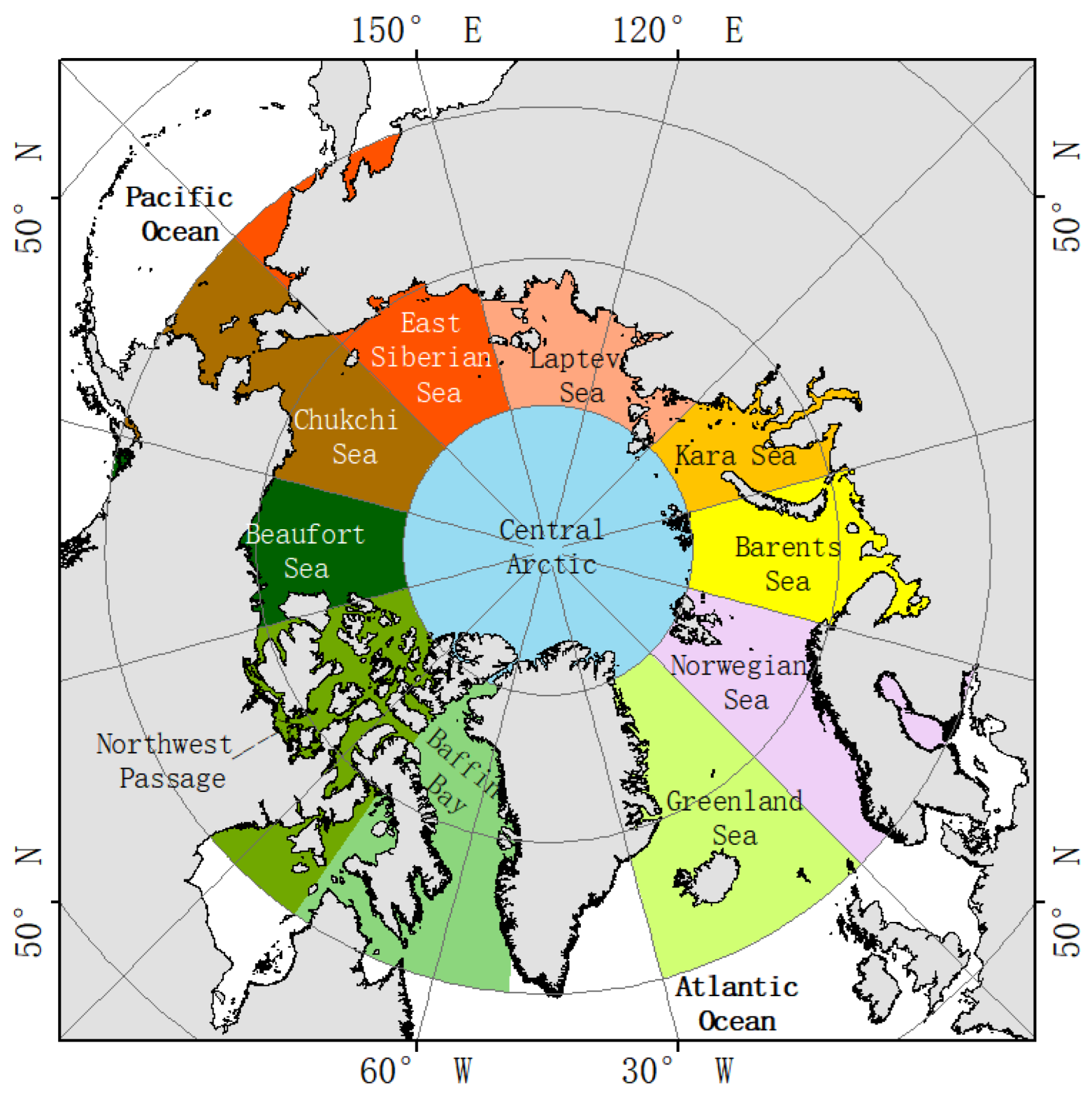



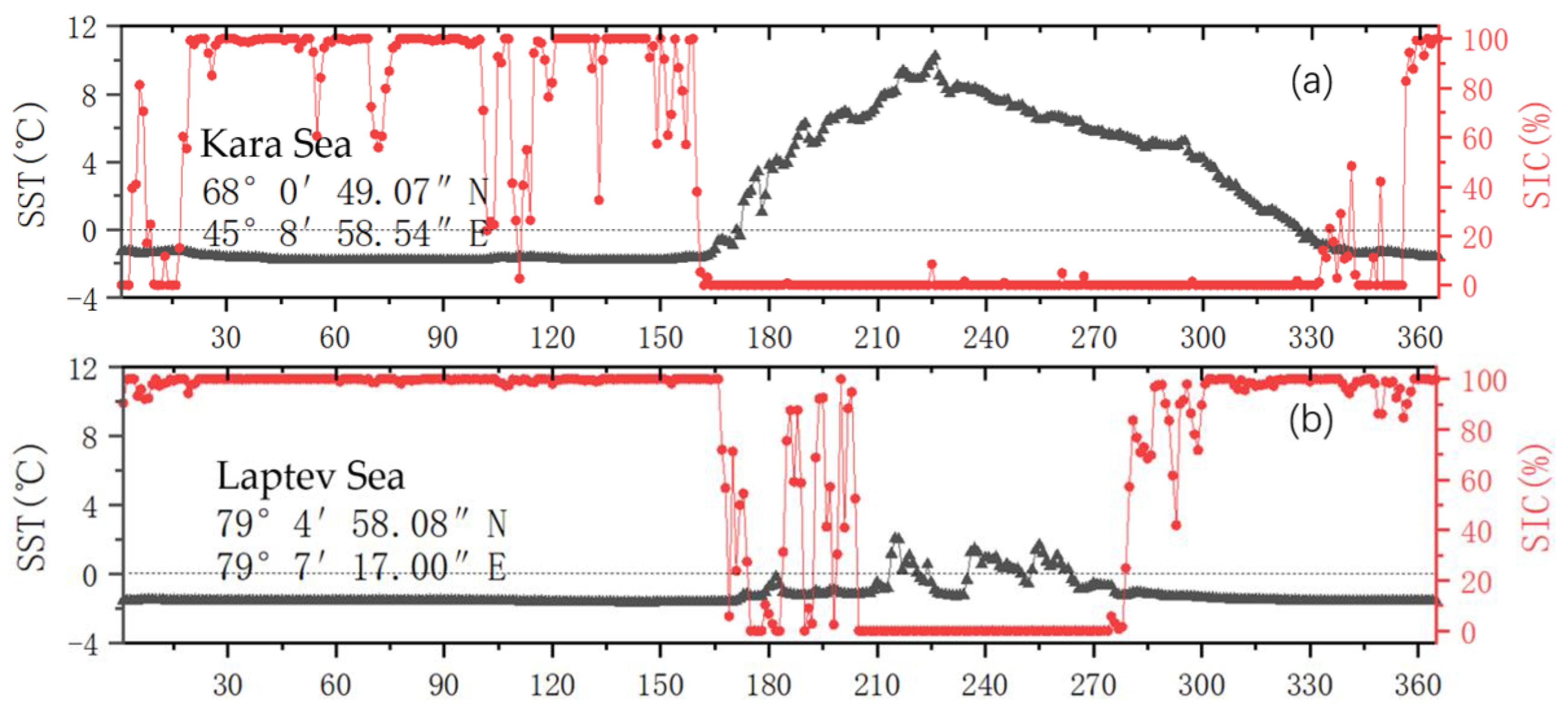
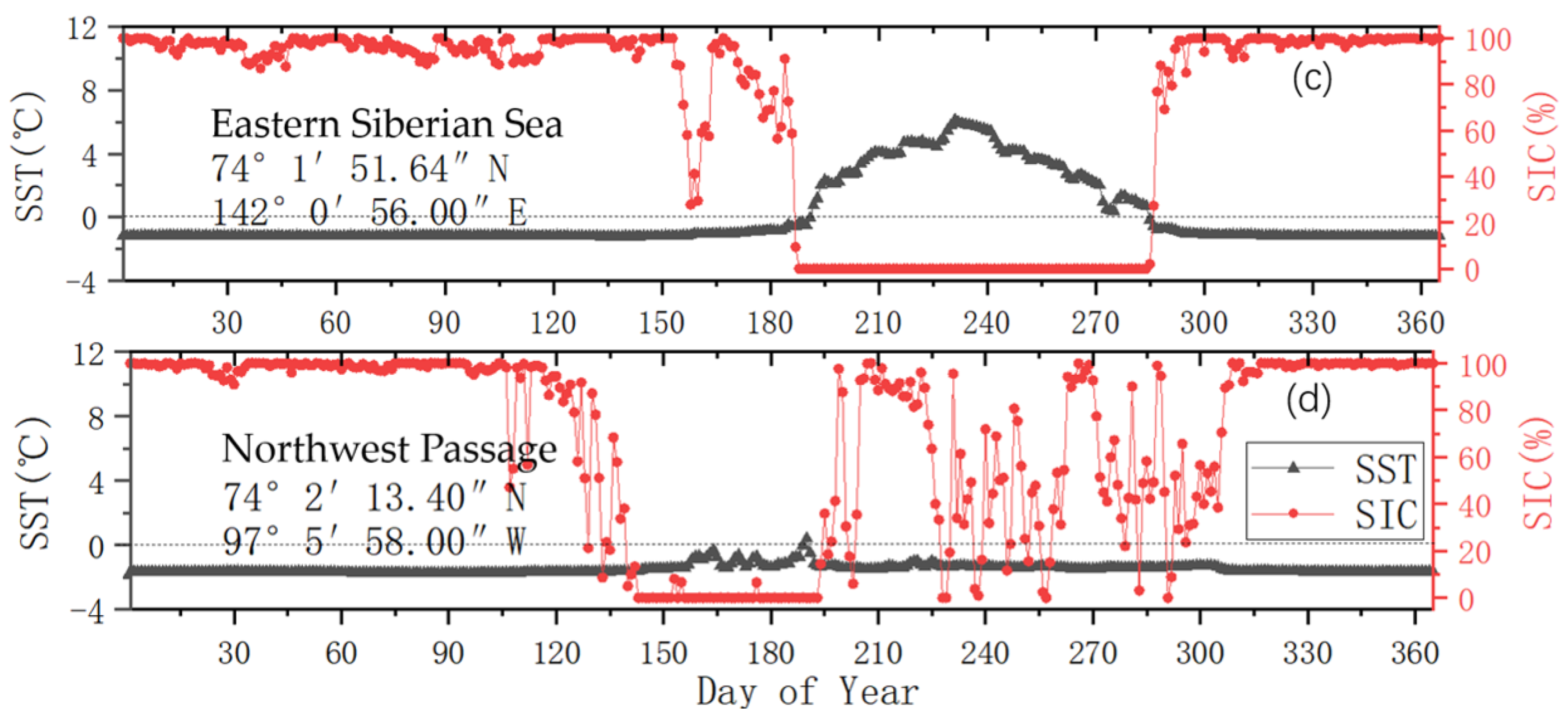
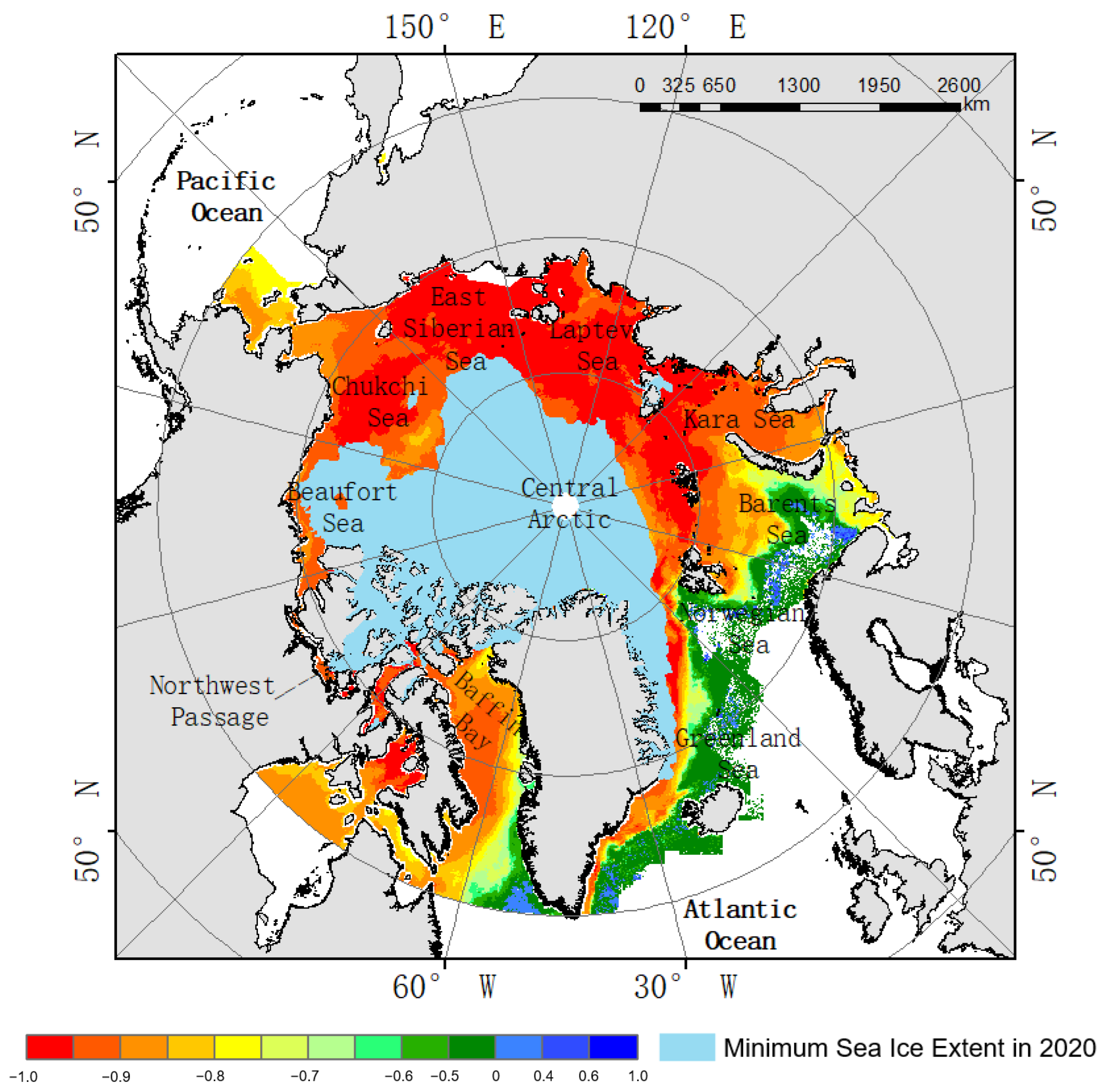
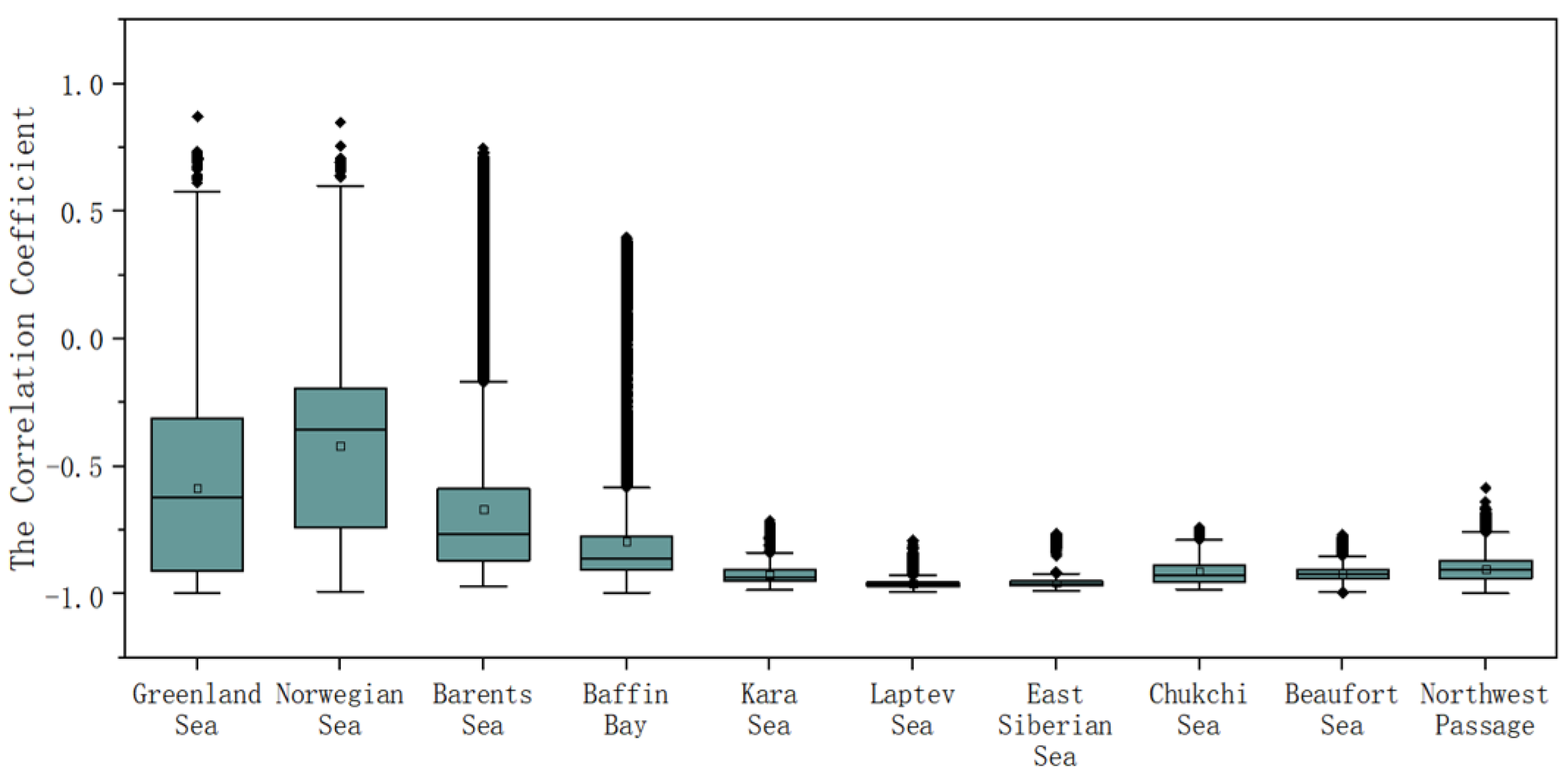



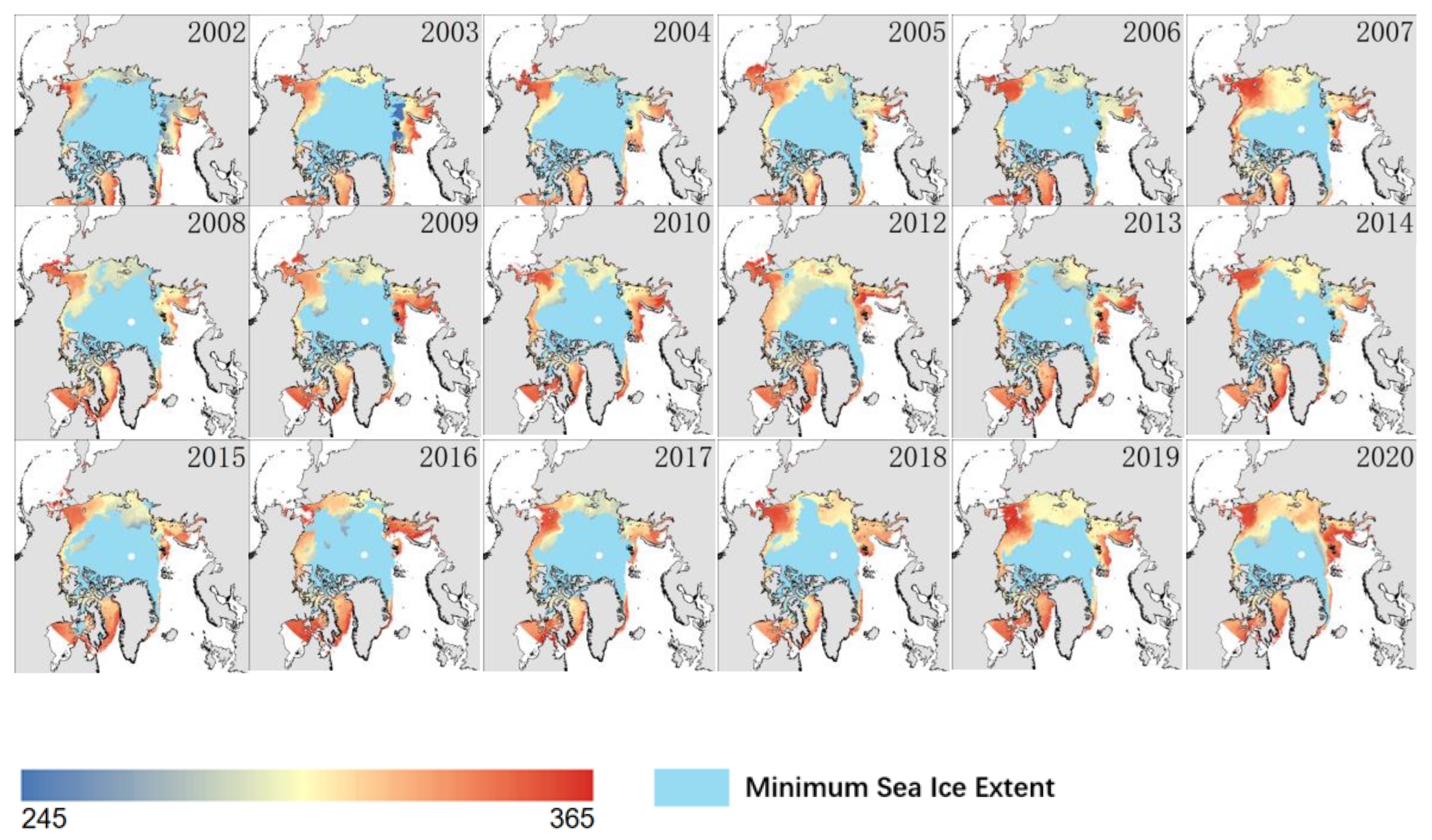
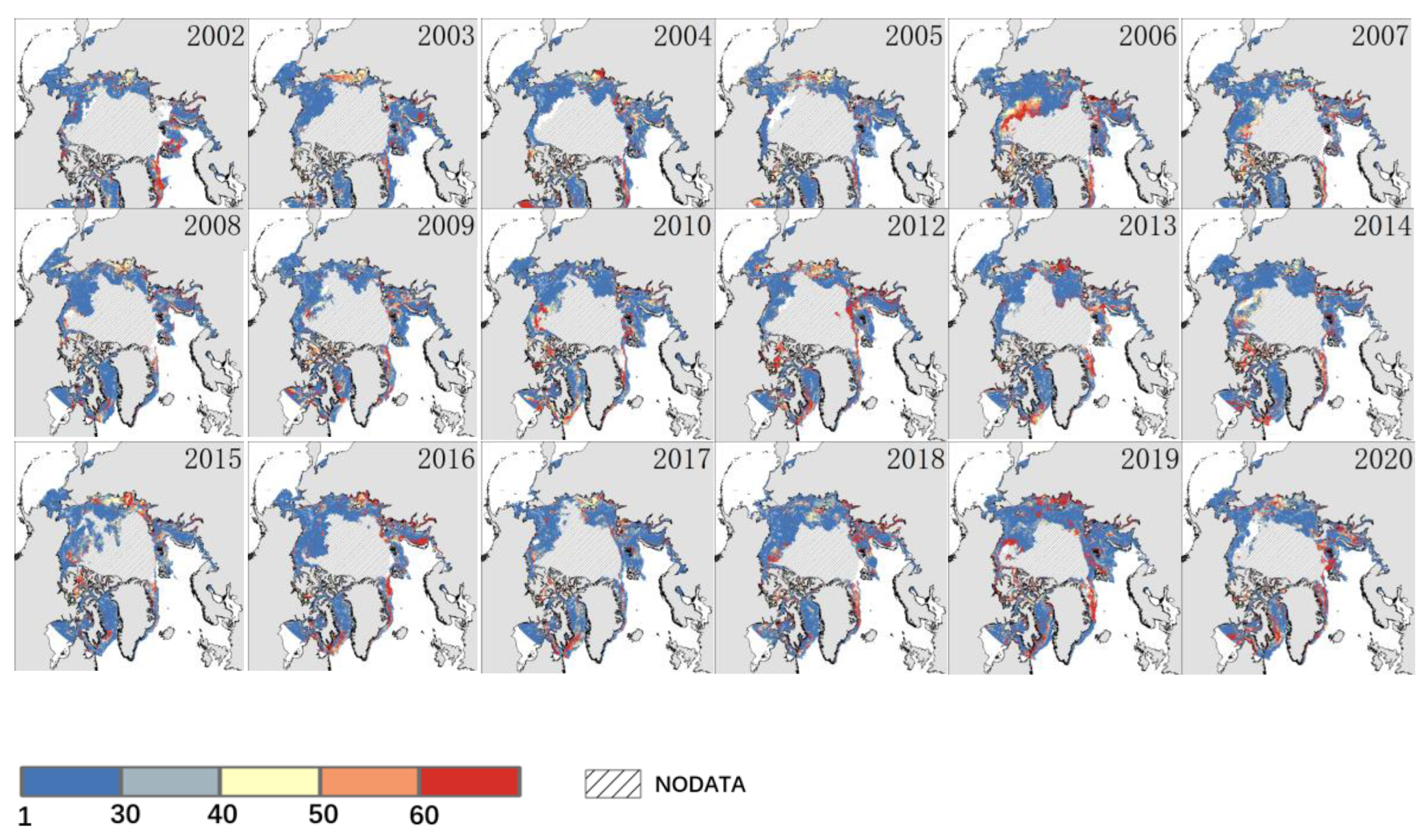


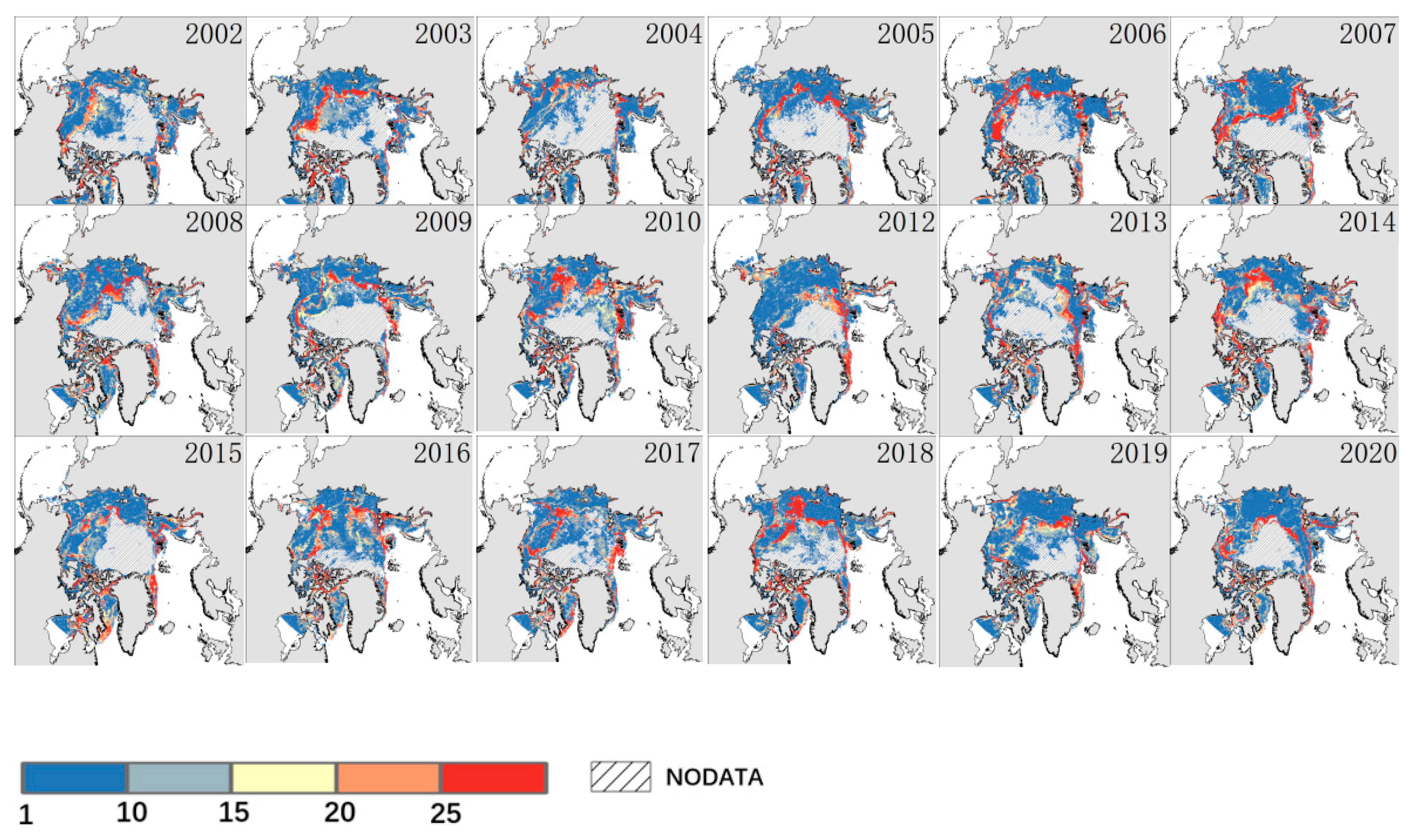


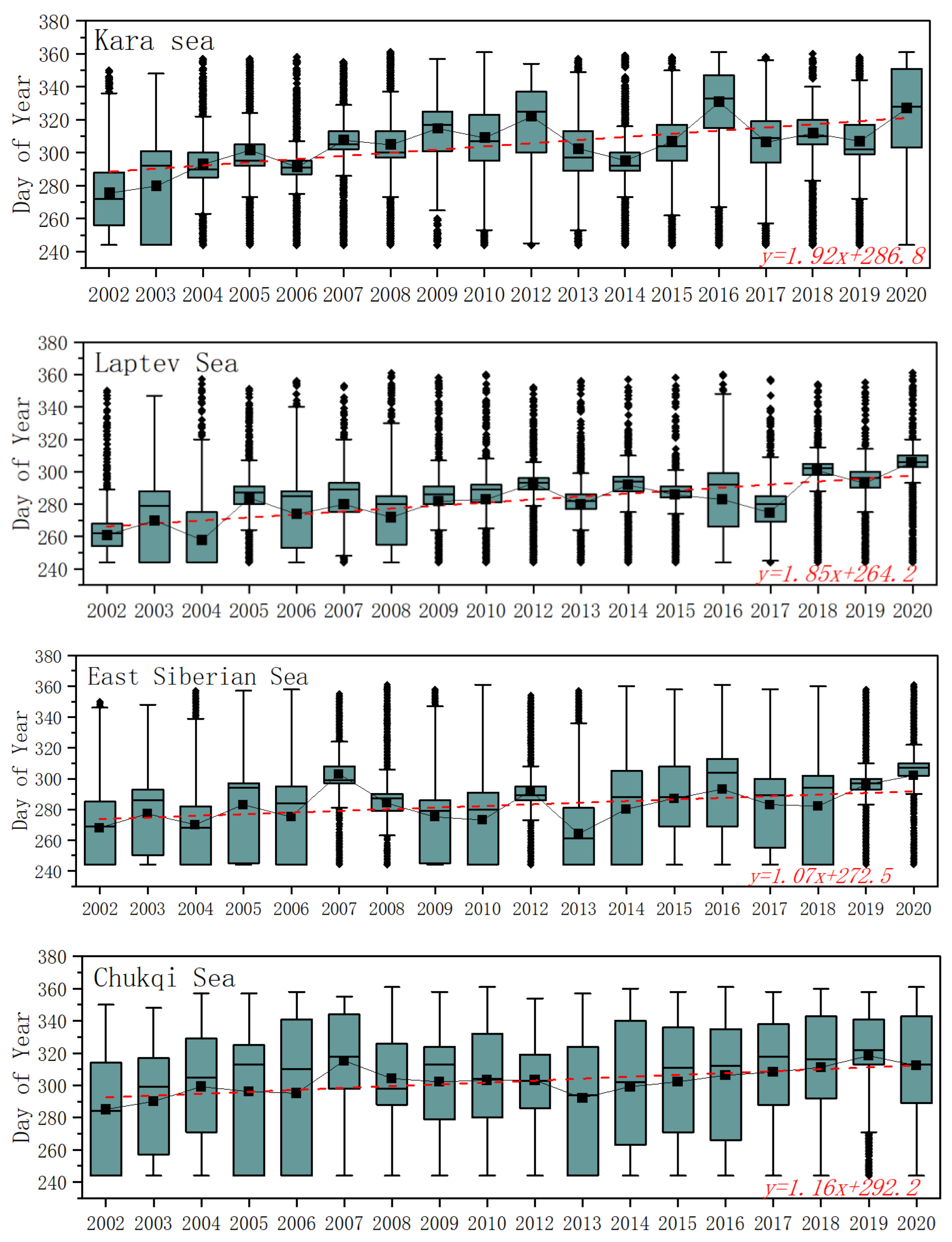
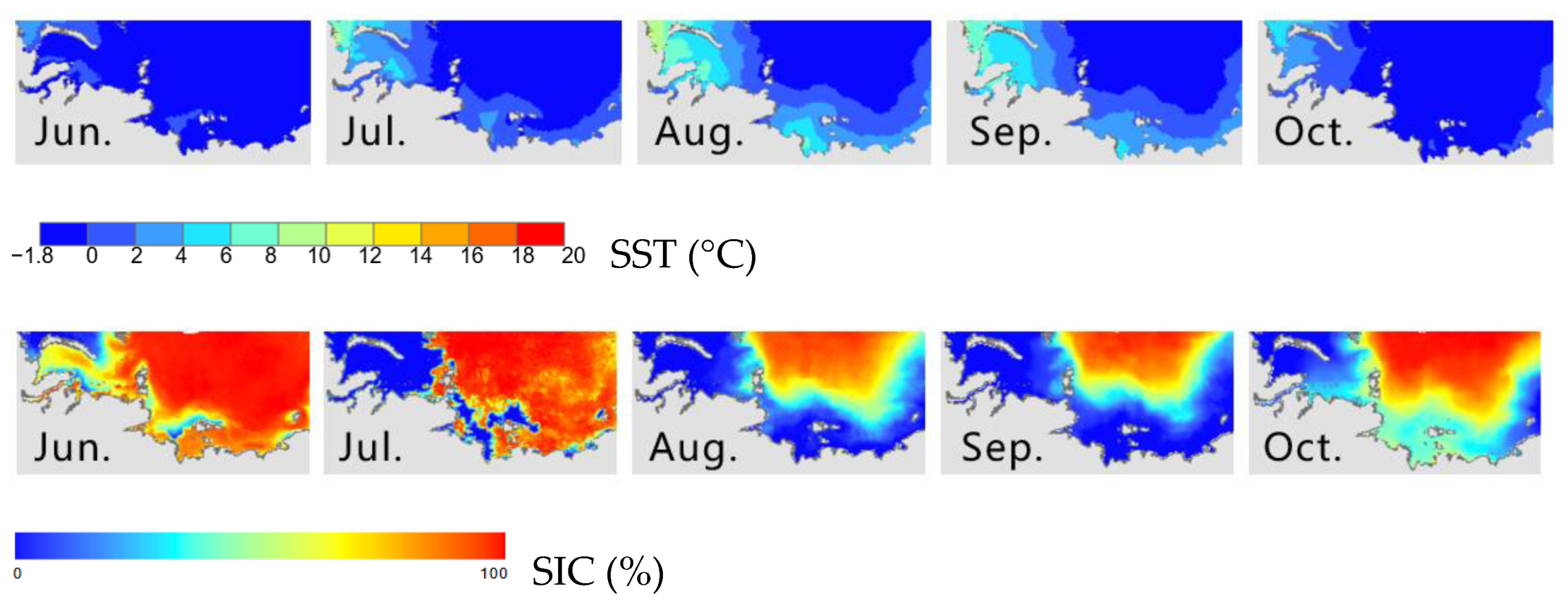
| Date | Maximum | Minimum |
|---|---|---|
| 2005 | 12 March | 20 September |
| 2006 | 12 March | 15 September * |
| 2007 | 12 March | 18 September |
| 2008 | 15 March * | 19 September |
| 2009 | 5 March | 13 September |
| 2010 | 31 March | 21 September |
| 2011 | 9 March | 11 September |
| 2012 | 15 March * | 17 September |
| 2013 | 28 February | 13 September |
| 2014 | 21 March | 17 September |
| 2015 | 25 February | 9 September |
| 2016 | 23 March | 10 September |
| 2017 | 7 March | 13 September |
| 2018 | 17 March | 23 September |
| 2019 | 13 March | 18 September |
| 2020 | 5 March | 16 September |
| 2021 | 21 March | 16 September |
| 2022 | 25 March | 18 September |
| Area | Winter | Spring | Summer | Autumn | ||||
|---|---|---|---|---|---|---|---|---|
| °C | % | °C | % | °C | % | °C | % | |
| Norwegian Sea | 4.15 | 4.89 | 3.83 | 6.59 | 7.58 | 1.52 | 6.54 | 0.89 |
| Barents Sea | 0.49 | 25.89 | 0.18 | 30.14 | 4.40 | 4.58 | 3.56 | 3.77 |
| Kara Sea | −1.53 | 86.16 | −1.42 | 88.64 | 1.69 | 27.37 | 1.00 | 25.13 |
| Laptev Sea | −1.63 | 98.24 | −1.49 | 95.09 | 0.41 | 45.61 | −0.26 | 49.64 |
| East Siberian Sea | −1.48 | 91.23 | −1.37 | 90.29 | 0.52 | 55.44 | 0.08 | 48.41 |
| Chukchi Sea | −1.42 | 84.20 | −1.33 | 84.55 | 1.81 | 38.07 | 1.11 | 28.65 |
| Beaufort Sea | −1.64 | 98.66 | −1.51 | 95.83 | 0.01 | 64.42 | −0.82 | 68.64 |
| Northwest Passage | −1.60 | 97.01 | −1.47 | 94.00 | 0.39 | 53.77 | −0.23 | 50.01 |
| Baffin Bay | −0.81 | 65.80 | −0.93 | 69.56 | 2.48 | 16.52 | 1.50 | 10.37 |
| Greenland Sea | 2.78 | 17.01 | 2.63 | 17.35 | 5.56 | 7.44 | 4.74 | 9.23 |
| Year | SST (°C) | SIC (%) |
|---|---|---|
| 2002 | −0.21 | 45.76 |
| 2003 | −0.16 | 55.30 |
| 2004 | −0.19 | 55.35 |
| 2005 | −0.09 | 53.49 |
| 2006 | −0.12 | 52.79 |
| 2007 | 0.01 | 50.16 |
| 2008 | −0.13 | 52.81 |
| 2009 | −0.20 | 53.12 |
| 2010 | −0.17 | 51.88 |
| 2011 | −0.13 | 47.89 |
| 2012 | 0.01 | 36.71 |
| 2013 | −0.06 | 52.59 |
| 2014 | −0.05 | 51.85 |
| 2015 | −0.05 | 50.99 |
| 2016 | 0.03 | 47.97 |
| 2017 | −0.12 | 49.84 |
| 2018 | −0.16 | 49.71 |
| 2019 | −0.12 | 48.55 |
| 2020 | 0.15 | 48.11 |
| 2021 | −0.22 | 50.91 |
| Year | Norwegian Sea | Barents Sea | Kara Sea | Laptev Sea | East Siberian Sea | Chukchi Sea | Beaufort Sea | Northwest Passage | Baffin Bay | Greenland Sea |
|---|---|---|---|---|---|---|---|---|---|---|
| 2002 | 96 | 119 | 167 | 171 | 179 | 161 | 184 | 167 | 132 | 101 |
| 2003 | 100 | 118 | 162 | 188 | 183 | 164 | 179 | 171 | 140 | 105 |
| 2004 | 96 | 113 | 162 | 170 | 180 | 167 | 177 | 163 | 136 | 103 |
| 2005 | 94 | 99 | 156 | 178 | 173 | 168 | 199 | 163 | 133 | 102 |
| 2006 | 97 | 105 | 147 | 152 | 169 | 149 | 158 | 162 | 137 | 103 |
| 2007 | 95 | 103 | 147 | 178 | 186 | 164 | 157 | 167 | 138 | 101 |
| 2008 | 97 | 107 | 158 | 172 | 185 | 171 | 181 | 172 | 138 | 102 |
| 2009 | 98 | 110 | 149 | 170 | 187 | 171 | 172 | 157 | 130 | 105 |
| 2010 | 97 | 106 | 139 | 163 | 181 | 161 | 173 | 163 | 133 | 103 |
| 2012 | 98 | 106 | 148 | 162 | 177 | 165 | 185 | 156 | 133 | 106 |
| 2013 | 96 | 105 | 158 | 154 | 185 | 161 | 176 | 168 | 134 | 103 |
| 2014 | 96 | 102 | 139 | 176 | 177 | 156 | 174 | 153 | 144 | 102 |
| 2015 | 94 | 96 | 137 | 168 | 178 | 159 | 156 | 157 | 136 | 102 |
| 2016 | 94 | 101 | 136 | 158 | 171 | 156 | 179 | 161 | 137 | 104 |
| 2017 | 93 | 106 | 162 | 160 | 180 | 154 | 179 | 164 | 138 | 100 |
| 2018 | 95 | 102 | 137 | 158 | 171 | 150 | 165 | 162 | 131 | 102 |
| 2019 | 94 | 102 | 136 | 148 | 161 | 159 | 168 | 152 | 125 | 99 |
| 2020 | 93 | 97 | 142 | 157 | 166 | 169 | 184 | 159 | 128 | 98 |
| 2021 | 100 | 119 | 167 | 171 | 179 | 161 | 184 | 167 | 132 | 101 |
| Year | Norwegian Sea | Barents Sea | Kara Sea | Laptev Sea | East Siberian Sea | Chukchi Sea | Beaufort Sea | Northwest Passage | Baffin Bay | Greenland Sea |
|---|---|---|---|---|---|---|---|---|---|---|
| 2002 | 101 | 136 | 198 | 193 | 193 | 161 | 189 | 186 | 154 | 111 |
| 2003 | 102 | 132 | 186 | 215 | 198 | 174 | 192 | 194 | 161 | 109 |
| 2004 | 98 | 125 | 183 | 199 | 192 | 166 | 174 | 193 | 158 | 107 |
| 2005 | 96 | 107 | 179 | 201 | 195 | 169 | 205 | 184 | 152 | 107 |
| 2006 | 99 | 114 | 176 | 185 | 187 | 175 | 190 | 195 | 157 | 109 |
| 2007 | 98 | 112 | 181 | 206 | 204 | 181 | 177 | 196 | 158 | 109 |
| 2008 | 100 | 119 | 187 | 200 | 196 | 179 | 196 | 193 | 158 | 105 |
| 2009 | 99 | 121 | 179 | 190 | 189 | 181 | 184 | 190 | 152 | 111 |
| 2010 | 100 | 117 | 166 | 186 | 186 | 173 | 188 | 194 | 157 | 104 |
| 2012 | 100 | 114 | 178 | 191 | 190 | 173 | 201 | 196 | 157 | 112 |
| 2013 | 99 | 115 | 188 | 184 | 187 | 170 | 184 | 190 | 157 | 110 |
| 2014 | 98 | 108 | 163 | 199 | 187 | 168 | 194 | 193 | 165 | 108 |
| 2015 | 96 | 103 | 159 | 202 | 197 | 172 | 176 | 188 | 153 | 107 |
| 2016 | 97 | 112 | 173 | 196 | 177 | 161 | 189 | 186 | 162 | 112 |
| 2017 | 95 | 116 | 183 | 189 | 189 | 157 | 194 | 190 | 161 | 104 |
| 2018 | 98 | 110 | 172 | 186 | 194 | 155 | 174 | 192 | 149 | 109 |
| 2019 | 98 | 112 | 158 | 177 | 181 | 177 | 196 | 187 | 148 | 106 |
| 2020 | 94 | 105 | 169 | 179 | 188 | 166 | 183 | 188 | 155 | 107 |
| 2021 | 101 | 136 | 198 | 193 | 193 | 161 | 189 | 186 | 154 | 111 |
| Year | Norwegian Sea | Barents Sea | Kara Sea | Laptev Sea | East Siberian Sea | Chukchi Sea | Beaufort Sea | Northwest Passage | Baffin Bay | Greenland Sea |
|---|---|---|---|---|---|---|---|---|---|---|
| 2002 | 311 | 304 | 276 | 261 | 268 | 286 | 256 | 274 | 316 | 297 |
| 2003 | 313 | 308 | 280 | 270 | 277 | 291 | 258 | 276 | 314 | 295 |
| 2004 | 323 | 314 | 293 | 258 | 270 | 300 | 259 | 273 | 317 | 294 |
| 2005 | 305 | 315 | 302 | 284 | 283 | 297 | 256 | 278 | 317 | 279 |
| 2006 | 307 | 305 | 291 | 274 | 275 | 296 | 261 | 290 | 327 | 279 |
| 2007 | 315 | 325 | 308 | 280 | 303 | 316 | 264 | 285 | 316 | 272 |
| 2008 | 303 | 313 | 305 | 272 | 284 | 305 | 269 | 284 | 317 | 290 |
| 2009 | 301 | 337 | 315 | 282 | 275 | 303 | 260 | 282 | 313 | 277 |
| 2010 | 326 | 329 | 309 | 283 | 273 | 304 | 270 | 290 | 320 | 294 |
| 2012 | 318 | 334 | 322 | 293 | 292 | 304 | 287 | 292 | 322 | 274 |
| 2013 | 333 | 333 | 303 | 280 | 264 | 293 | 259 | 280 | 318 | 292 |
| 2014 | 299 | 302 | 296 | 292 | 280 | 300 | 264 | 278 | 322 | 286 |
| 2015 | 302 | 335 | 307 | 286 | 287 | 303 | 272 | 284 | 313 | 279 |
| 2016 | 290 | 336 | 331 | 283 | 293 | 307 | 281 | 289 | 325 | 283 |
| 2017 | 329 | 323 | 307 | 275 | 283 | 309 | 275 | 281 | 313 | 303 |
| 2018 | 314 | 331 | 312 | 301 | 282 | 312 | 260 | 276 | 311 | 289 |
| 2019 | 304 | 322 | 307 | 293 | 296 | 319 | 275 | 288 | 328 | 289 |
| 2020 | 336 | 343 | 327 | 306 | 302 | 313 | 263 | 287 | 324 | 286 |
| 2021 | 311 | 304 | 276 | 261 | 268 | 286 | 256 | 274 | 316 | 297 |
| Year | Norwegian Sea | Barents Sea | Kara Sea | Laptev Sea | East Siberian Sea | Chukchi Sea | Beaufort Sea | Northwest Passage | Baffin Bay | Greenland Sea |
|---|---|---|---|---|---|---|---|---|---|---|
| 2002 | 311 | 308 | 287 | 271 | 272 | 293 | 264 | 286 | 325 | 303 |
| 2003 | 314 | 312 | 289 | 282 | 287 | 299 | 272 | 289 | 319 | 300 |
| 2004 | 328 | 317 | 304 | 267 | 277 | 305 | 266 | 283 | 325 | 302 |
| 2005 | 309 | 316 | 310 | 292 | 289 | 304 | 264 | 290 | 325 | 287 |
| 2006 | 292 | 310 | 301 | 285 | 284 | 302 | 275 | 302 | 332 | 290 |
| 2007 | 311 | 331 | 316 | 291 | 309 | 323 | 278 | 296 | 323 | 282 |
| 2008 | 308 | 318 | 315 | 283 | 290 | 311 | 282 | 297 | 327 | 300 |
| 2009 | 310 | 346 | 327 | 293 | 284 | 309 | 270 | 294 | 324 | 283 |
| 2010 | 336 | 336 | 321 | 294 | 289 | 309 | 281 | 301 | 330 | 302 |
| 2012 | 316 | 340 | 329 | 300 | 297 | 311 | 295 | 302 | 329 | 290 |
| 2013 | 348 | 341 | 316 | 291 | 268 | 296 | 266 | 292 | 328 | 306 |
| 2014 | 307 | 311 | 309 | 300 | 293 | 306 | 276 | 292 | 331 | 297 |
| 2015 | 289 | 342 | 320 | 294 | 293 | 306 | 282 | 297 | 327 | 294 |
| 2016 | 286 | 345 | 340 | 298 | 302 | 313 | 292 | 302 | 334 | 295 |
| 2017 | 342 | 332 | 317 | 284 | 291 | 314 | 285 | 292 | 325 | 312 |
| 2018 | 341 | 334 | 322 | 308 | 297 | 320 | 271 | 289 | 321 | 301 |
| 2019 | 315 | 331 | 318 | 301 | 301 | 326 | 284 | 299 | 334 | 301 |
| 2020 | 349 | 350 | 335 | 315 | 309 | 319 | 275 | 298 | 331 | 298 |
| 2021 | 311 | 308 | 287 | 271 | 272 | 293 | 264 | 286 | 325 | 303 |
| Year | Norwegian Sea | Barents Sea | Kara Sea | Laptev Sea | East Siberian Sea | Chukchi Sea | Beaufort Sea | Northwest Passage | Baffin Bay | Greenland Sea |
|---|---|---|---|---|---|---|---|---|---|---|
| 2002 | 30 | 25 | 33 | 28 | 26 | 18 | 26 | 31 | 28 | 45 |
| 2003 | 20 | 22 | 24 | 37 | 29 | 13 | 22 | 33 | 28 | 25 |
| 2004 | 18 | 24 | 22 | 32 | 23 | 16 | 16 | 42 | 29 | 36 |
| 2005 | 12 | 15 | 23 | 27 | 35 | 19 | 19 | 30 | 25 | 29 |
| 2006 | 23 | 23 | 32 | 33 | 19 | 29 | 36 | 37 | 26 | 45 |
| 2007 | 28 | 26 | 34 | 35 | 24 | 20 | 28 | 35 | 23 | 44 |
| 2008 | 26 | 24 | 30 | 31 | 23 | 15 | 25 | 30 | 23 | 29 |
| 2009 | 13 | 17 | 30 | 25 | 22 | 17 | 23 | 37 | 29 | 35 |
| 2010 | 23 | 20 | 28 | 24 | 23 | 20 | 34 | 37 | 31 | 34 |
| 2012 | 19 | 18 | 31 | 33 | 34 | 19 | 24 | 44 | 32 | 31 |
| 2013 | 30 | 26 | 32 | 31 | 24 | 18 | 17 | 30 | 27 | 41 |
| 2014 | 22 | 19 | 25 | 24 | 19 | 20 | 31 | 43 | 25 | 46 |
| 2015 | 21 | 23 | 25 | 42 | 25 | 19 | 26 | 34 | 21 | 35 |
| 2016 | 27 | 30 | 38 | 42 | 20 | 14 | 14 | 31 | 29 | 38 |
| 2017 | 20 | 20 | 22 | 30 | 30 | 17 | 26 | 32 | 29 | 27 |
| 2018 | 30 | 26 | 37 | 31 | 28 | 15 | 27 | 39 | 23 | 46 |
| 2019 | 32 | 20 | 23 | 29 | 28 | 22 | 43 | 41 | 29 | 48 |
| 2020 | 21 | 20 | 30 | 23 | 30 | 17 | 19 | 36 | 33 | 39 |
| 2021 | 30 | 25 | 33 | 28 | 26 | 18 | 26 | 31 | 28 | 45 |
| Year | Norwegian Sea | Barents Sea | Kara Sea | Laptev Sea | East Siberian Sea | Chukchi Sea | Beaufort Sea | Northwest Passage | Baffin Bay | Greenland Sea |
|---|---|---|---|---|---|---|---|---|---|---|
| 2002 | 14 | 13 | 12 | 12 | 9 | 12 | 11 | 15 | 14 | 14 |
| 2003 | 13 | 12 | 12 | 12 | 12 | 11 | 18 | 18 | 12 | 14 |
| 2004 | 9 | 9 | 11 | 14 | 12 | 10 | 11 | 15 | 12 | 16 |
| 2005 | 16 | 11 | 10 | 9 | 11 | 11 | 14 | 15 | 14 | 16 |
| 2006 | 12 | 13 | 10 | 11 | 13 | 16 | 21 | 16 | 12 | 21 |
| 2007 | 15 | 15 | 11 | 12 | 7 | 12 | 21 | 13 | 13 | 19 |
| 2008 | 21 | 14 | 13 | 13 | 9 | 11 | 14 | 15 | 14 | 19 |
| 2009 | 35 | 16 | 12 | 12 | 12 | 9 | 14 | 15 | 16 | 16 |
| 2010 | 20 | 15 | 12 | 11 | 17 | 10 | 13 | 16 | 15 | 16 |
| 2012 | 18 | 12 | 15 | 8 | 7 | 9 | 8 | 12 | 12 | 24 |
| 2013 | 16 | 12 | 14 | 11 | 10 | 12 | 13 | 15 | 15 | 20 |
| 2014 | 27 | 18 | 15 | 9 | 17 | 11 | 16 | 17 | 14 | 19 |
| 2015 | 25 | 13 | 16 | 8 | 10 | 11 | 10 | 15 | 18 | 27 |
| 2016 | 22 | 14 | 12 | 15 | 10 | 17 | 13 | 16 | 15 | 18 |
| 2017 | 26 | 15 | 13 | 9 | 11 | 11 | 12 | 14 | 17 | 15 |
| 2018 | 24 | 11 | 11 | 7 | 19 | 14 | 15 | 16 | 15 | 18 |
| 2019 | 23 | 14 | 12 | 8 | 8 | 12 | 10 | 13 | 13 | 18 |
| 2020 | 20 | 12 | 15 | 9 | 9 | 11 | 16 | 14 | 14 | 19 |
| 2021 | 14 | 13 | 12 | 12 | 9 | 12 | 11 | 15 | 14 | 14 |
Disclaimer/Publisher’s Note: The statements, opinions and data contained in all publications are solely those of the individual author(s) and contributor(s) and not of MDPI and/or the editor(s). MDPI and/or the editor(s) disclaim responsibility for any injury to people or property resulting from any ideas, methods, instructions or products referred to in the content. |
© 2023 by the authors. Licensee MDPI, Basel, Switzerland. This article is an open access article distributed under the terms and conditions of the Creative Commons Attribution (CC BY) license (https://creativecommons.org/licenses/by/4.0/).
Share and Cite
Yang, M.; Qiu, Y.; Huang, L.; Cheng, M.; Chen, J.; Cheng, B.; Jiang, Z. Changes in Sea Surface Temperature and Sea Ice Concentration in the Arctic Ocean over the Past Two Decades. Remote Sens. 2023, 15, 1095. https://doi.org/10.3390/rs15041095
Yang M, Qiu Y, Huang L, Cheng M, Chen J, Cheng B, Jiang Z. Changes in Sea Surface Temperature and Sea Ice Concentration in the Arctic Ocean over the Past Two Decades. Remote Sensing. 2023; 15(4):1095. https://doi.org/10.3390/rs15041095
Chicago/Turabian StyleYang, Meng, Yubao Qiu, Lin Huang, Maoce Cheng, Jianguo Chen, Bin Cheng, and Zhengxin Jiang. 2023. "Changes in Sea Surface Temperature and Sea Ice Concentration in the Arctic Ocean over the Past Two Decades" Remote Sensing 15, no. 4: 1095. https://doi.org/10.3390/rs15041095
APA StyleYang, M., Qiu, Y., Huang, L., Cheng, M., Chen, J., Cheng, B., & Jiang, Z. (2023). Changes in Sea Surface Temperature and Sea Ice Concentration in the Arctic Ocean over the Past Two Decades. Remote Sensing, 15(4), 1095. https://doi.org/10.3390/rs15041095







